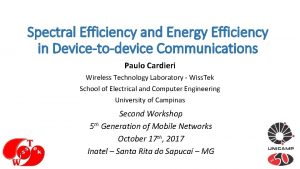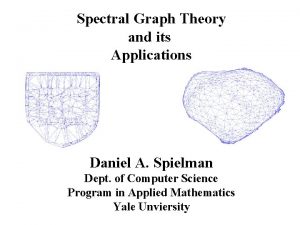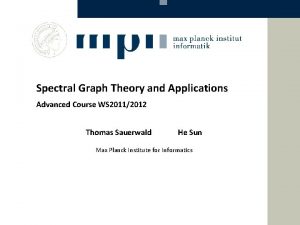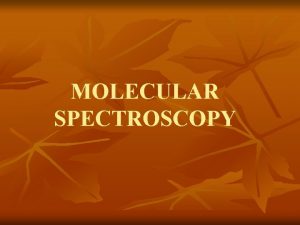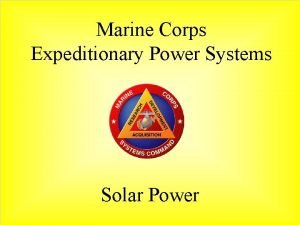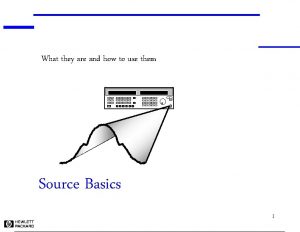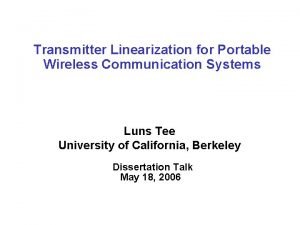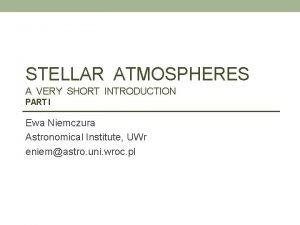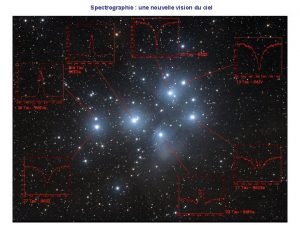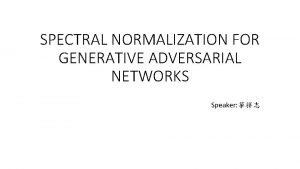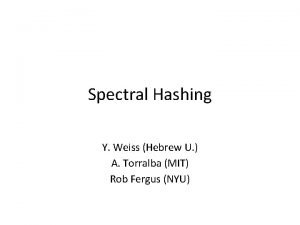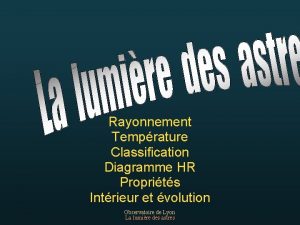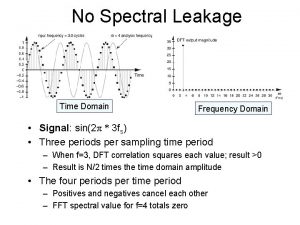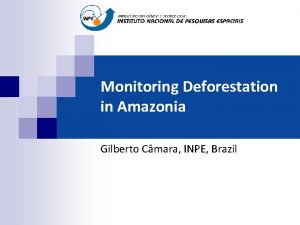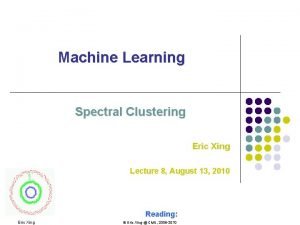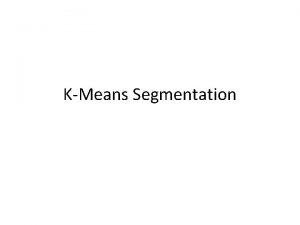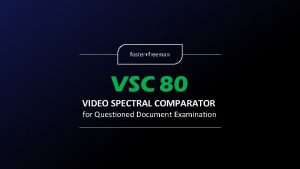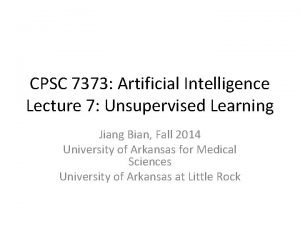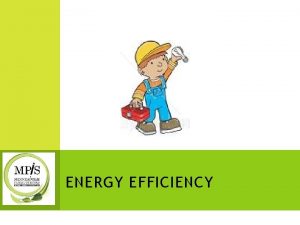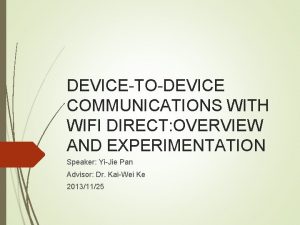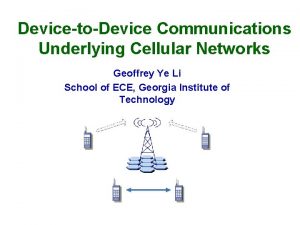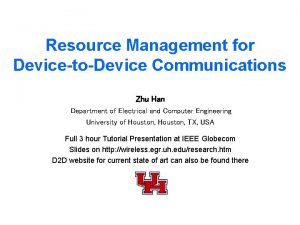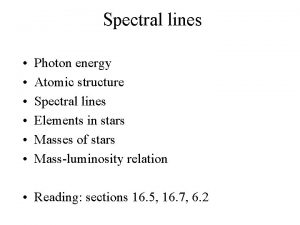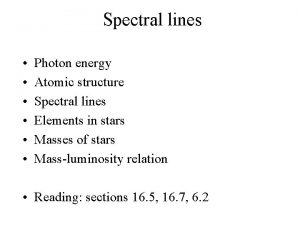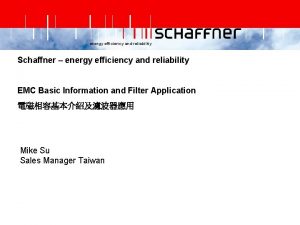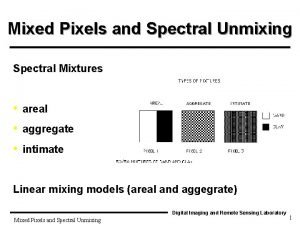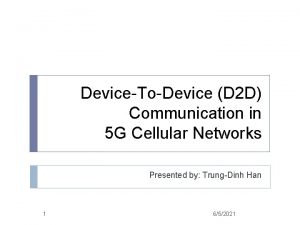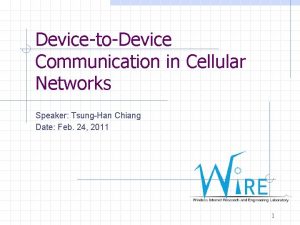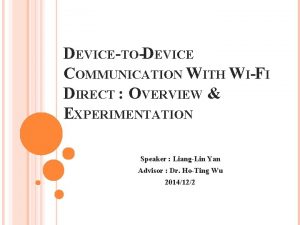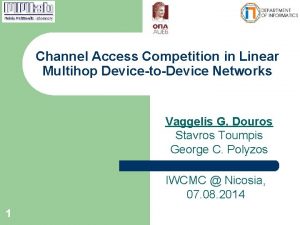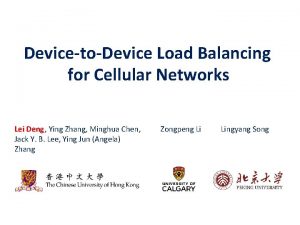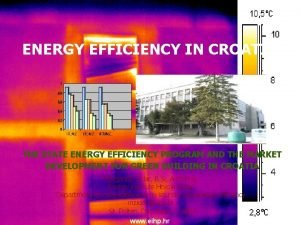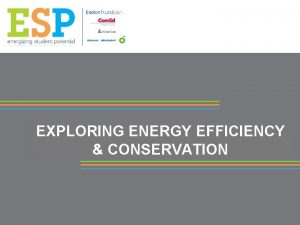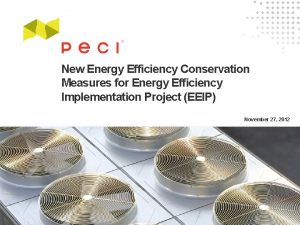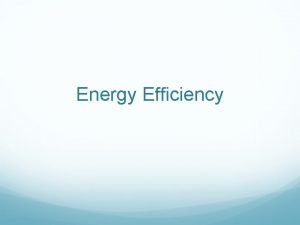Spectral Efficiency and Energy Efficiency in Devicetodevice Communications
















![Enhancing the network model (1) Mode of operation [2] • Mode selection q Potential Enhancing the network model (1) Mode of operation [2] • Mode selection q Potential](https://slidetodoc.com/presentation_image/09ccae8518600381361b8e3c9c2b5d1a/image-17.jpg)






- Slides: 23

Spectral Efficiency and Energy Efficiency in Device-to-device Communications Paulo Cardieri Wireless Technology Laboratory - Wiss. Tek School of Electrical and Computer Engineering University of Campinas Second Workshop 5 th Generation of Mobile Networks October 17 th, 2017 Inatel – Santa Rita do Sapucaí – MG

Summary • Basic ideas • A multitude of scenarios • Performance metrics • Simple model – some results • Enhancing the models • Next steps

Device-to-device communications • Communication between two User Equipments (UEs) in a cellular network is allowed: • Improved channel reuse in the cell: spectral efficiency • Reduced transmit power: lower interference level • Reduced traffic load: lower interference level • Reduced traffic in the core network (information traffic between base stations in no longer needed)

Several possible scenarios In coverage, same cell Same cell, partial coverage Partial coverage, relay In coverage, different cells Out of coverage

More scenarios… Resource allocation: • In-band: D 2 D UEs use the cellular band • Out-of-band: D 2 D UEs use other bands (e. g. , ISM) Spectrum sharing: • In-band overlay: D 2 D and cellular UEs use orthogonal resources • In-band underlay: D 2 D and cellular UEs share the same radio resources • Requires interference management UE link: • Single hop vs. multihop

Network models We are usually interested in analyzing the overall network capacity: • Aggregate of transmission rate • Average delay, etc. Interference is a key player in the network performance Models must include: • Interaction among cellular and D 2 D terminals • Location of terminals and base stations • Propagation channel effects

Modeling location of terminals • Spatial Point Processes: describes in statistical manner possible patterns of node locations, within a given class. • Instead of a detailed, particular description of node locations • Poisson Point Process (PPP) • • Only one parameter: intensity l (density of nodes) Nodes are randomly distributed in a 2 D region Number of nodes per unit area: Poisson distributed Allows for closed-form expressions: Moment Generating Function of the aggregate interference

Spatial Point Processes usually employed in wireless network models • Poisson Point Process • Matern Point Process • Poisson-Poisson cluster process

Performance Metrics Some typical performance metrics • Transmission capacity: Average data rate successfully transmitted per unit area • Spatially averaged spectral efficiency • Local Delay

Simple model of D 2 D – Cellular network • Two disjoint classes of user terminals: • Cellular • D 2 D • One cellular terminal per cell • Several D 2 D terminals per cell • D 2 D terminals access channel with a given access probability p • TX-RX separation distances are fixed (both cellular and D 2 D) • D 2 D transmissions use uplink cellular channel

Simple model of D 2 D – Cellular network •

Network model D 2 D link Base station Cellular terminal D 2 D terminal Cellular link

Outage probabilities Cellular terminals: D 2 D terminals:

Spectral efficiency and Energy efficiency D 2 D Spectral Efficiency: D 2 D Energy Efficiency

Simple model of D 2 D – Cellular network We want to keep the performance of cellular links unaffected, as we attempt to increase the spectral efficiency of D 2 D links: • Node density (or access probability) and transmit power of D 2 D terminals must be appropriately controlled [1]: Fixed D 2 D power control: [1] Pimentel, H. B. , Cardieri, P. , “Optimization of Transmission Capacity of Cognitive Radio Networks, " submitted.

Spectral efficiency and Energy Efficiency Spectral Efficiency Energy Efficiency
![Enhancing the network model 1 Mode of operation 2 Mode selection q Potential Enhancing the network model (1) Mode of operation [2] • Mode selection q Potential](https://slidetodoc.com/presentation_image/09ccae8518600381361b8e3c9c2b5d1a/image-17.jpg)
Enhancing the network model (1) Mode of operation [2] • Mode selection q Potential D 2 D UE UE 1 -q Cellular UE D 2 D mode: Cellular mode: Receiver location: • D 2 D receiver is randomly distributed around the D 2 D transmitter • Cellular receiver is randomly distributed inside the serving cell [2] X. Lin, J. G. Andrews and A. Ghosh, "Spectrum Sharing for Device-to-Device Communication in Cellular Networks, " in IEEE Transactions on Wireless Communications, vol. 13, no. 12, pp. 6727 -6740, Dec. 2014.

Enhancing the network model (2) Spatial point processes: Cellular transmitters: cellular UE + potential D 2 D in cellular mode • PPP, with effective density Potential D 2 D UE in D 2 D mode: • PPP, with effective density

Enhancing the network model (3) • Potential D 2 D UEs autonomously decide whether or not to operate on D 2 D mode, based on sensing the channel. • Opportunistic access • Reduced communication overhead • D 2 D mode: channel must be idle in the spatial domain [3]: Spatial spectrum sensing • Channel is available if no active cellular UE is located inside the region surrounding that potential D 2 E UE. [3] H. Chen; L. Liu; T. Novlan; J. Matyjas; B. L. Ng; C. Zhang, "Spatial Spectrum Sensing based Device-to-Device (D 2 D) Cellular Networks, " in IEEE Transactions on Wireless Communications , vol. PP, no. 99, pp. 1 -1

Enhancing the network model (4) Base station Cellular terminal Active D 2 D terminal Inactive D 2 D terminal D 2 D link Cellular link

Resulting Spatial Point Processes Thinning process • Thinning process is locationdependent • Resulting point process is a Poisson Hole Process (no longer a Poisson Point Process) • Difficult to analyze Cellular UE Active D 2 D UE • Investigation on good approximations is needed. Potential D 2 D UE in [3] H. Chen; L. Liu; T. Novlan; J. Matyjas; B. L. Ng; C. Zhang, "Spatial Spectrum Sensing based Device-to. D 2 D mode Device (D 2 D) Cellular Networks, " in IEEE Transactions on Wireless Communications , vol. PP, no. 99, pp. 1 -1

Next Steps • Formulate performance metrics under this more general network model • Energy efficiency, spectral efficiency • Delay: imperfect spectrum sensing causes mutual interference between D 2 D UE and cellular UE - Coupled queues

Thank you
 Spectral efficiency
Spectral efficiency Renewable energy and energy efficiency partnership
Renewable energy and energy efficiency partnership Allocative efficiency vs productive efficiency
Allocative efficiency vs productive efficiency Productively efficient vs allocatively efficient
Productively efficient vs allocatively efficient Productively efficient vs allocatively efficient
Productively efficient vs allocatively efficient Energy energy transfer and general energy analysis
Energy energy transfer and general energy analysis Energy energy transfer and general energy analysis
Energy energy transfer and general energy analysis Spectral graph theory and its applications
Spectral graph theory and its applications Spectral graph theory course
Spectral graph theory course Rotational spectral lines
Rotational spectral lines Solar portable alternative communications energy system
Solar portable alternative communications energy system Spectral regrowth
Spectral regrowth Spectral regrowth
Spectral regrowth Spectral classification
Spectral classification Profil spectral rigel
Profil spectral rigel Spectral normalization for generative adversarial networks
Spectral normalization for generative adversarial networks Spectral hashing
Spectral hashing Séquence principale
Séquence principale Spectral leakage
Spectral leakage Spectral bands
Spectral bands Cmu machine learning
Cmu machine learning Spectral clustering
Spectral clustering Video spectral comparator
Video spectral comparator Spectral clustering
Spectral clustering
